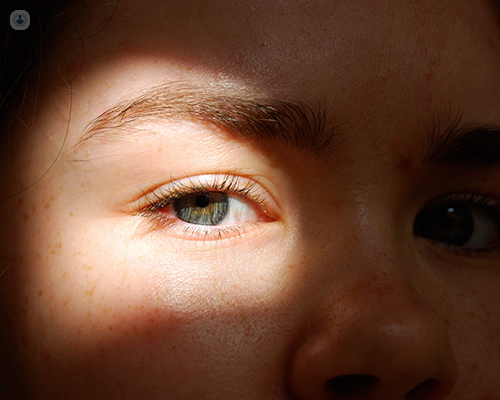Spot the multiple forms of cutaneous lupus
Written by:Cutaneous lupus is caused by an autoimmune response in which the immune system attacks healthy skin cells by mistake, leading to inflammation and red rashes. Highly esteemed consultant dermatologist, Dr Derrick Philips, provides an expert insight into this condition.

What is cutaneous lupus?
Lupus is an autoimmune condition that can affect a wide range of organs. Cutaneous lupus is the variant of lupus that only affects the skin. There are various different types of cutaneous lupus with different clinical features. Patients with cutaneous lupus may develop the systemic form, with multiorgan involvement and immune abnormalities over time.
What does cutaneous lupus look like?
The different forms of cutaneous lupus have different rashes.
Discoid lupus typically has pink scaly patches on the face, neck, scalp and ears, and can cause changes in pigmentation and scarring, which leads to hair loss in the scalp (alopecia).
Subactue lupus is a scaly, ring-like rash, typically on the torso and limbs. It usually does not typically affect the face and does not heal with scarring.
Tumid lupus is a bumpy red rash that can look like hives.
Lupus panniculitis is a rare type of cutaneous lupus in which there is inflammation and scarring of the fat in the skin. It can result in calcified lumps in the skin.
Chilblains lupus looks like tender red-purple lumps on fingers, toes and ears.
Occasionally, patients with systemic lupus develop a facial rash called acute lupus. It is a butterfly shaped red rash affecting the cheeks and nose but notably sparing the crease between the cheeks and the nose, called the nasolabial fold.
What triggers cutaneous lupus?
Cutaneous lupus is an autoimmune disease in which antibodies develop that attack the skin. It is not clear what causes it but some families carry genes that increase the risk of developing cutaneous lupus. Certain medications have also been associated with the development of cutaneous lupus.
How is cutaneous lupus diagnosed?
Cutaneous lupus is usually diagnosed with a skin biopsy, where a sample of the affected skin is examined under a microscope. The sample contains typical features which can be seen by a pathologist. A special test called direct immunofluorescence can also be performed on the biopsy sample to confirm the diagnosis. Blood tests may also demonstrate positive antibodies.
How is cutaneous lupus treated?
Local treatments such as corticosteroids and calcineurin inhibitors are used to suppress inflammation caused by cutaneous lupus when small areas are affected. When the rash is more widespread, oral treatments are usually required. Antimalarials such as hydroxychloroquine and mepacrine, are the most commonly used treatments. Oral steroids and immunosuppressants like methotrexate may be required for extensive disease that does not respond to antimalarials.
Most forms of cutaneous lupus are aggravated by the sun. High factor sunscreen (SPF50 and 5 UVA stars) is therefore an important part of any treatment regime.
Dr Derrick Philips is a highly esteemed London-based consultant dermatologist who specialises in the treatment of several skin problems including psoriasis, acne and rosacea. If you’re living with cutaneous lupus and wish to seek expert treatment, make sure to visit Dr Philips’ Top Doctors profile today.


